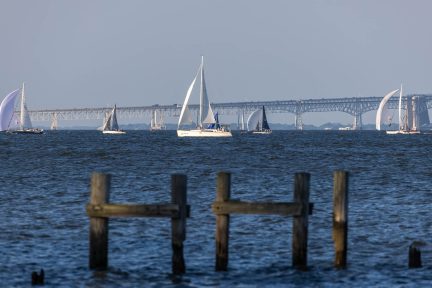Record amount of freshwater impacts Bay water quality
Record amount of freshwater impacts Bay water quality
The Chesapeake Bay Program announced today that an estimated 38% of the Chesapeake Bay and its tidal tributaries met clean water standards for clarity (measured by underwater grass abundance), dissolved oxygen and chlorophyll a (a measure of algae growth) between 2016 and 2018. This score is lower than the record high 42% from the previous reporting period but is still the fifth highest estimate of water quality standards attainment since 1985.
This four percentage point decrease from the previous assessment period is due in large part to a decline in dissolved oxygen in the open waters of the Bay, those areas beyond the shoreline and shallows. Dissolved oxygen is necessary for the survival of the Bay’s aquatic species, and is a factor in the annual dead zone. However, dissolved oxygen conditions in deep water habitat (depths greater than six feet) and measures of chlorophyll a along the Bay’s surface shows improvement from the 2015-2017 assessment period, which may indicate increasing resilience. However, water quality must improve in 62% of the Chesapeake Bay and its tidal tributaries if the estuary is to function as a healthy ecosystem.
Water quality is influenced by nitrogen, phosphorus and sediment loads delivered from the watershed and varies each year due to land use and river flow. The U.S. Geological Survey (USGS) reports that between October 2017 and September 2018, river flow to the Bay measured an above-average 70.5 billion gallons per day, the highest recorded amount since 2011.
Generally, when the watershed receives more rain and river flows increase, the water carries more nitrogen, phosphorus and sediment pollution than usual, increasing loads received by the Bay. This remained true from October 2017 to September 2018 as approximately 423 million pounds of nitrogen, 42.1 million pounds of phosphorus and 15,689 million pounds of sediment reached the Bay: a 66%, 181% and 262% increase from the previous year, respectively. However, the pollutant loads recorded during this time period were a decrease from those observed in 2011, which held the previous record for high flow rates into the Bay.
Monitoring data collected from River Input Monitoring (RIM) stations on the nine largest rivers in the watershed provide the foundation for experts to estimate the total nitrogen, phosphorus and sediment entering the Chesapeake Bay and its tidal tributaries each year, while data collected from a comprehensive network of hundreds of stations in non-tidal waters allow experts to assess the aquatic response to efforts to reduce agricultural and urban runoff.
The amount of nitrogen, phosphorus and sediment entering the Bay is dependent on variations in weather patterns each year. To this end, it is important to analyze trends over time to understand whether the health of the Bay and its tidal waters are improving or declining. Findings from a recent USGS analysis of short-term trends (2009 to 2018) in pollution loads monitored at the nine RIM stations report the following:
- Short-term trends in nitrogen indicate improving conditions at three stations (James, Patuxent and Potomac) and degrading conditions at five stations.
- Short-term trends in phosphorus indicate improving conditions at the James and Patuxent stations, degrading conditions at four stations and unchanged conditions at the Pamunkey, Potomac and Susquehanna stations.
- Short-term trends in sediment loads indicate improving conditions at the James and Susquehanna stations, degrading conditions at five and no change at the Patuxent and Potomac stations.
The USGS conducted a similar analysis of nitrogen, phosphorus and sediment loads using monitoring data captured at the upstream non-tidal network stations. Short-term trends (2009 to 2018) show the following:
- Forty-one percent of non-tidal network stations report an improvement in nitrogen loads, while 40% are degrading and the remaining 19% show no change.
- Phosphorus loads are improving at 44% of non-tidal network stations, while one-third are degrading, and the remainder show no change.
- Twenty percent of non-tidal network stations show an improvement in sediment loads, with 42% degrading and the remainder showing no change.
Improvements in water quality will take time, and there are often lags between the implementation of BMPs and the visible effects of those practices on a particular waterway. This spring, the Chesapeake Bay Program released the 2018-19 Bay Barometer: Health and Restoration in the Chesapeake Bay Watershed, which further explains how the entire Chesapeake Bay ecosystem and its watershed are responding to the partnership’s collective protection and restoration efforts.
Facts
The USGS works with state partners to monitor nitrogen, phosphorus and sediment loads entering the Chesapeake Bay from nine RIM stations, which together reflect the nitrogen, phosphorus and sediment loads delivered to the Bay from almost 80 percent of its watershed.
To estimate pollution loads delivered from the remaining 20 percent of the watershed, the Chesapeake Bay Program pairs this data with nitrogen and phosphorus levels in water samples collected at wastewater treatment plants, computer-simulated estimates of nitrogen and phosphorus loads from nonpoint pollution sources (e.g. rainfall) and computer-simulated estimates of the atmospheric deposition of nitrogen to tidal waters.
The USGS also determines long-term and short-term trends in nitrogen, phosphorus and sediment loads and works with the U.S. Environmental Protection Agency (EPA) and state partners to collect monitoring data at more than 100 non-tidal monitoring stations to assess the aquatic response to efforts to reduce agricultural and urban runoff.
These pollution load estimates, which are derived from land use and BMP implementation, are just one in a suite of tools the EPA uses to evaluate whether jurisdictions (Delaware, the District of Columbia, Maryland, New York, Pennsylvania, Virginia and West Virginia) are on track to meet the Chesapeake Bay Total Maximum Daily Load and its two-year milestone commitments. The EPA also considers data and information on BMP implementation and effectiveness, as well as the progress each jurisdiction makes toward putting programs in place to achieve pollutant reductions.
Water quality in the Chesapeake Bay and its tidal tributaries is evaluated using three parameters: dissolved oxygen, water clarity or underwater grass abundance and chlorophyll a (a measure of algae growth). These parameters are monitored at hundreds of stations across the Chesapeake Bay and its tidal tributaries by the Maryland Department of Natural Resources, the Virginia Department of Environmental Quality and the District Department of Energy and Environment. The resulting data is used to develop an indicator of the estimated attainment of a set of water quality standards that can be monitored at this time. If the Bay and its tidal tributaries are to function as a healthy ecosystem, all water quality standards for all tidal aquatic habitats must be met.
Issues
Excess nitrogen, phosphorus and sediment are among the leading causes of the Bay’s poor health. Nitrogen and phosphorus can fuel the growth of algae blooms that lead to low-oxygen dead zones in deep waters. These conditions can suffocate plant and animal life and reduce the habitat available to them.
Sediment can block sunlight from reaching underwater grasses and suffocate and bury shellfish. Pollution reducing practices used in backyards, in cities and on farms can reduce the flow of nitrogen, phosphorus and sediment into waterways. Management actions taken to decrease loads from point sources (e.g. wastewater treatment plants) may immediately show detectable pollution changes, but in regard to the implementation of BMPs for non-point sources, there is often a lag in measuring their impact on improving water quality and the health of the Bay.
Quotes
“Improved water quality is critical for providing habitat for fisheries and recreation for the 18 million people in the watershed. The monitoring and associated analysis are the foundation for assessing progress in restoring water-quality conditions Bay and its watershed.”
- Scott Phillips, Co-Chair, Science, Technical, Assessment and Reporting Workgroup and Chesapeake Bay Coordinator, U.S. Geological Survey
“This relatively small decline in water quality standards attainment, during a period that included near record rainfall for much of the Bay watershed, is actually an indication that our collective management actions are working. It also underscores the importance of the decisions made by the Chesapeake Bay Program to estimate and offset the anticipated impacts of climate change on our ability to meet water quality goals in the future.”
- James Martin, Co-Chair, Water Quality Goal Implementation Team and Chesapeake Bay Coordinator, Virginia Department of Environmental Quality
“While any decrease in water quality is disappointing, we have more monitoring resources in place than ever before from volunteer and community-based monitoring programs through the Bay watershed. The Chesapeake Monitoring Cooperative provides the opportunity for local organizations and individuals to enhance our existing water quality data with what they are seeing in their own communities and backyards, and we are excited to integrate this data into the Chesapeake Bay Program in order to get a more holistic view of the health of the Bay and it's watershed.”
- Liz Chudoba, Water Quality Program Director, Alliance for the Chesapeake Bay



